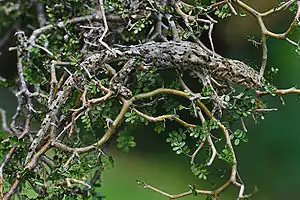List of geckos of New Zealand
Three genera of geckos are native to New Zealand – Hoplodactylus, Naultinus and Toropuku.

All species are viviparous, giving birth to live young, typically twins. This feature makes them virtually unique in the family Gekkonidae, as only one species outside New Zealand (from New Caledonia) has the same reproductive habit. New Zealand geckos are omnivorous – their diet is primarily insectivorous in nature – flies, spiders, moths etc., but they will supplement it with fruit (i.e. from mahoe) and nectar (i.e. from flax flowers) when it is available.[1]
Geckos are often a target for wildlife smugglers.
Species
- Dactylocnemis pacificus – Pacific gecko or Pacific sticky-toed gecko
- Hoplodactylus delcourti – kawekaweau, Delcourt's sticky-toed gecko, or Delcourt's giant gecko
- Hoplodactylus duvaucelii – Duvaucel's gecko or forest gecko
- Hoplodactylus maculatus – common gecko, New Zealand common gecko, or Raukawa gecko
- Mokopirirakau cryptozoicus – Takitimu gecko
- Mokopirirakau kahutarae – black-eyed gecko
- Mokopirirakau granulatus – forest gecko
- Mokopirirakau nebulosus – cloudy gecko
- Naultinus elegans – Auckland green gecko
- Naultinus gemmeus – jewelled gecko
- Naultinus grayii – Northland green gecko or Gray's tree gecko
- Naultinus manukanus – Marlborough green gecko or manuka gecko
- Naultinus punctatus – Wellington green gecko
- Naultinus rudis – rough gecko
- Naultinus stellatus – Nelson green gecko or starry tree gecko
- Naultinus tuberculatus – West Coast green gecko, Lewis Pass green gecko, or warty tree gecko
- Toropuku stephensi – Stephen's Island gecko or Cook Strait striped gecko
- Toropuku inexpectatus
- Woodworthia brunnea – Canterbury gecko
- Woodworthia chrysosiretica – gold-striped gecko, gold-stripe gecko, or golden sticky-toed gecko
- Woodworthia maculata – New Zealand common gecko or Raukawa gecko
New species
The number of gecko species in New Zealand was previously 16 but with a spate of discoveries of new animals in the last five years this figure is steadily rising. First of all, it appears that animals with a wide range previously thought to comprise a single species actually represent multiple sub-species, as with the common gecko, Hoplodactylus maculatus.[2]
Secondly, a number of alpine species in the genus Hoplodactylus are now emerging from high altitude discoveries in the South Island including the Takitimu gecko, Hoplodactylus cryptozoicus. Kawekaweau (Hoplodactylus delcourti), or Delcourt's giant gecko, is an extinct gecko that grew to a length of 600 millimetres (24 in). The only documented sighting is that by a Maori chief who found and killed one in 1870.[2]
References
- Brian Gill and Tony Whitaker (1996). New Zealand frogs and reptiles. David Bateman Ltd.
- Bauer AM, Russell AP. "Hoplodactylus delcourti n. sp. (Reptilia: Gekkonidae), the largest known gecko" Archived 2013-04-20 at the Wayback Machine, New Zealand Journal of Zoology (1986), Vol. 13: 141–148. doi:10.1080/03014223.1986.10422655
Further reading
- New Zealand Geckos; A guide to captive maintenance and breeding, RPV Rowlands, Ecoprint, 1999